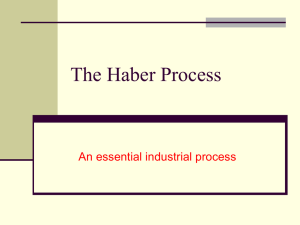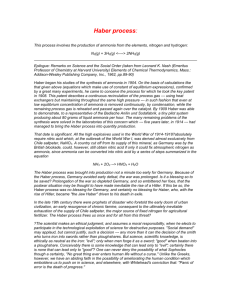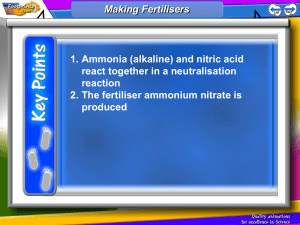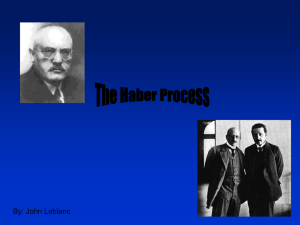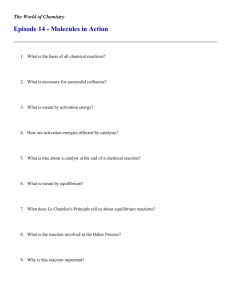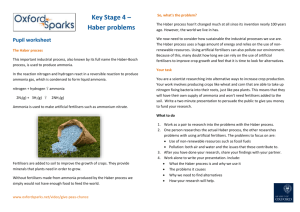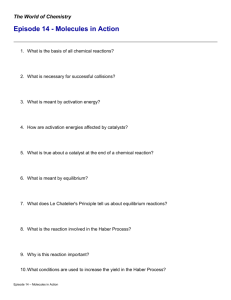083. Fritz Haber - University of Cincinnati
advertisement
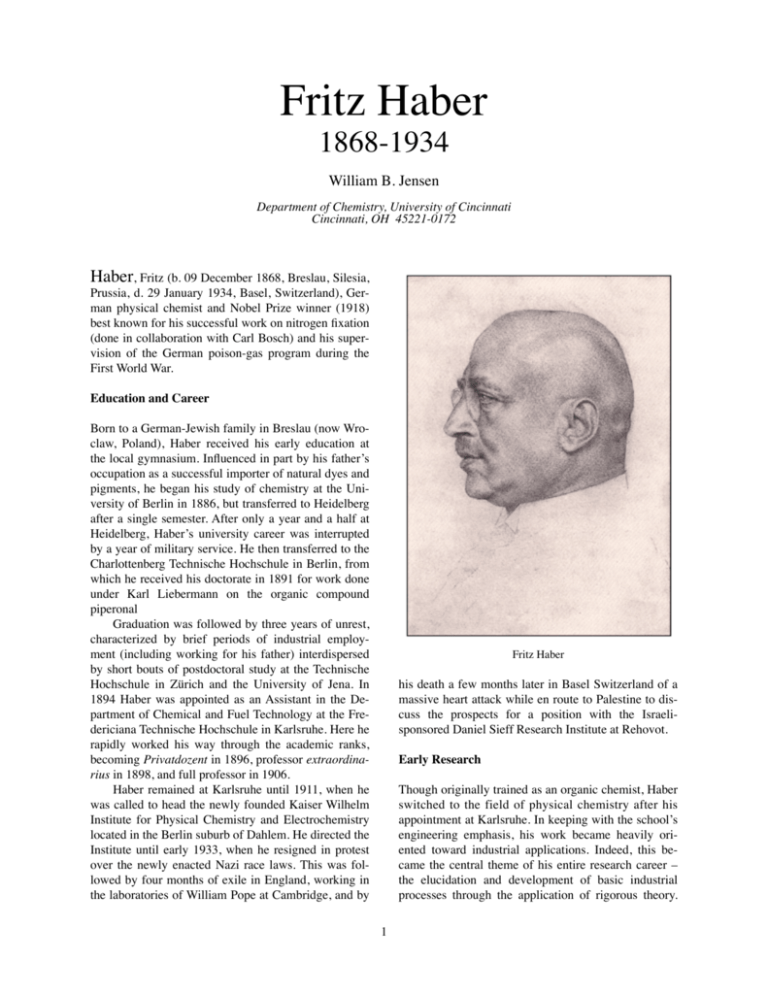
Fritz Haber 1868-1934 William B. Jensen Department of Chemistry, University of Cincinnati Cincinnati, OH 45221-0172 Haber, Fritz (b. 09 December 1868, Breslau, Silesia, Prussia, d. 29 January 1934, Basel, Switzerland), German physical chemist and Nobel Prize winner (1918) best known for his successful work on nitrogen fixation (done in collaboration with Carl Bosch) and his supervision of the German poison-gas program during the First World War. Education and Career Born to a German-Jewish family in Breslau (now Wroclaw, Poland), Haber received his early education at the local gymnasium. Influenced in part by his father’s occupation as a successful importer of natural dyes and pigments, he began his study of chemistry at the University of Berlin in 1886, but transferred to Heidelberg after a single semester. After only a year and a half at Heidelberg, Haber’s university career was interrupted by a year of military service. He then transferred to the Charlottenberg Technische Hochschule in Berlin, from which he received his doctorate in 1891 for work done under Karl Liebermann on the organic compound piperonal Graduation was followed by three years of unrest, characterized by brief periods of industrial employment (including working for his father) interdispersed by short bouts of postdoctoral study at the Technische Hochschule in Zürich and the University of Jena. In 1894 Haber was appointed as an Assistant in the Department of Chemical and Fuel Technology at the Fredericiana Technische Hochschule in Karlsruhe. Here he rapidly worked his way through the academic ranks, becoming Privatdozent in 1896, professor extraordinarius in 1898, and full professor in 1906. Haber remained at Karlsruhe until 1911, when he was called to head the newly founded Kaiser Wilhelm Institute for Physical Chemistry and Electrochemistry located in the Berlin suburb of Dahlem. He directed the Institute until early 1933, when he resigned in protest over the newly enacted Nazi race laws. This was followed by four months of exile in England, working in the laboratories of William Pope at Cambridge, and by Fritz Haber his death a few months later in Basel Switzerland of a massive heart attack while en route to Palestine to discuss the prospects for a position with the Israelisponsored Daniel Sieff Research Institute at Rehovot. Early Research Though originally trained as an organic chemist, Haber switched to the field of physical chemistry after his appointment at Karlsruhe. In keeping with the school’s engineering emphasis, his work became heavily oriented toward industrial applications. Indeed, this became the central theme of his entire research career – the elucidation and development of basic industrial processes through the application of rigorous theory. 1 WILLIAM B. JENSEN His initial work involved the physical chemistry of flames and combustion and led to his first published book in 1896, entitled Experimental Untersuchungen iiber Zerstetzung und Verbrennung von Kohenwasserstoffen (Experimental Investigations on the Decomposition and Combustion of Hydrocarbons), which also served as his habilitation thesis for promotion to Privatdozent. This work would later prove valuable in elucidating the chemistry behind the refining and cracking of petroleum. Beginning about 1897 Haber added an interest in the theory and industrial applications of electrochemistry to his growing list of research themes. One result of his intensive efforts to master the literature in this field was his second book, Grundriss der technischen Elektrochemie auf theoretischer Grundlage (The Theoretical Basis of Technical Electrochemistry), published in 1898. Among his contributions in this area were his studies of the electrochemical preparation of several important organic compounds, such as nitrobenzene (1904), his study of the hydrogen-oxygen fuel cell (1907), and his pioneering work on the glass electrode (1909). Work on the first of these topics led to a second book on electrochemistry entitled Die elektrolytischen Prozesse der organischen Chemie (The Electrolytic Processes of Organic Chemistry), published in 1910 and written in collaboration with Alexander Moser, whereas work on the third topic formed the basis for the later development of the pH meter. In 1904 Haber added yet a third research theme in the form of a growing interest in the thermodynamics of gas reactions. Here again his preliminary survey of the literature resulted in a book, Thermodynamik technischer Gasreaktionen (The Thermodynamics of Technical Gas Reactions), first published in 1905 and translated into English in 1908. His work in this area soon focused on the synthesis of ammonia gas from dinitrogen and dihydrogen gas and its potential as a method of nitrogen fixation. In 1898 the British chemist, William Crookes, had warned that the world’s population would soon outstrip its food production unless crop yields were increased through the use of nitrogen fertilizers. Though the atmosphere is 78% nitrogen by volume, this nitrogen is unavailable to plants unless it is first “fixed” in the form of a watersoluble compound such as ammonia or various nitrates. By 1909 Haber was able to show that the use of high pressures in combination with a suitable catalyst, immediate removal of the ammonia formed through rapid cooling, and repeated recycling of any unreacted dinitrogen and dihydrogen, made the ammonia synthesis practical and the process was turned over to Carl Bosch at the Badische Anilin- und Soda-Fabrik (BASF) for industrial development. In 1911 the first ammonia plant was built at Ludwigshafen-Oppau and by 1913 it was producing over 30 tons of fixed nitrogen per day. In 1918 Haber was awarded the Nobel Prize in Chemistry for his role in the ammonia synthesis and in 1931 Carl Bosch belatedly received a Nobel Prize for his contributions as well. World War I With the coming of World War I, Haber wholeheartedly devoted the resources of his research institute to meeting Germany’s war-time demands for chemical products and synthetic substitutes. Most of his published work during this period concerned the refinement of the ammonia synthesis. When coupled with the Ostwald process for the oxidation of ammonia to nitric acid, the process held the key not only to fertilizer and food production but also to the synthesis of nitrates and other explosives so essential to the war effort. Requests from the military for possible tear gases and other irritants, also led Haber to propose the use of chlorine as a war gas, a suggestion fIrst tried at Ypres in April of 1915. The use of gas warfare agents rapidly increased on both sides of the conflict and by 1916 Haber found himself acting as the Head of Germany’s Chemical Warfare Service. After the war, Haber was severely criticized and, in some cases, even ostracized for both his involvement the gas warfare program and his role in the ammonia synthesis. It was argued that British naval power would have cut off Germany’s access to natural nitrate deposits in Northern Chili and ended the war within a few months had not the ammonia process given Germany the ability to make its own nitrates and explosives. These criticisms overlooked the positive role of the synthesis in fertilizer production and the fact that British, French, and American chemists were more than willing to develop poison gas agents and explosives for their own governments. Postwar Years In the postwar years, Haber’s increasing administrative responsibilities, combined with his involvement in several international scientific organizations and his fame as a Nobel prize winner, led to a decline in his output of purely technical papers and to a simultaneous increase in his output of popular articles and lectures. Many of these were collected together in two volumes, Fünf Vorträge aus den Jahren 1920-1923 (Five Lectures from the Years 1920-1923) and Aus Leben und Beruf: Aufsätze, Reden, Vorträge (From Life and Work: Essays, Speeches, Lectures), published in 1924 and 1927 respectively. Technical projects of interest during 2 FRITZ HABER this period include his unsuccessful attempt (19221927) to pay Germany’s war debt by extracting gold from sea water and his proposal (1919) of a simple graphical method for calculating the energies of ionic crystals. Universally known as the Born-Haber cycle, this procedure is discussed in most inorganic and in many general chemistry textbooks. Select Annotated Bibliography * Morris Goran, The Story of Fritz Haber, University of Oklahoma: Norman, OK, 1967. The only book-length biography of Haber in English. Suitable for the general reader. Contains a bibliography of Haber’s publications with translated titles. * Ralf Hahn, Gold aus dem Meer: Die Forschungen des Nobelpreistragers Fritz Haber in den Jahren 1922-1927, GNT Verlag: Berlin, 1999. A German-language account of Haber’s attempts to extract gold from sea water. * Dietrich Stoltzenberg, Fritz Haber: Chemiker, Nobelpreistrager, Deutscher, Jude, VCH: Weinheim, 1995. Extensive German-language biography with heavy emphasis on the social, political and personal aspects of Haber’s career. Scheduled to appear in English translation in late 2000. * Margit Szöllösi-Janze, Fritz Haber, 1868-1934: Eine Biographie, Beck: Miinchen, 1998. The most recent Germanlanguage biography. Contains a bibliography of Haber’s publications with original German titles. Personal Life Not only was Haber’s public life steeped in controversy, his private life was touched with tragedy as well. His mother had died in giving birth to him and there evidence that this resulted in a life-long strain between Haber and his father. Haber’s first wife, Clara Immerwahr, committed suicide in 1915, ostensibly in protest against Haber’s involvement in the gas warfare program, and his second marriage to Charlotta Nathan ended in divorce in 1927. Haber had a son (Hermann) by his first wife and both a daughter (Eva) and son (Ludwig) by his second wife. Ludwig (or Lutz) became a well-known economist and historian of industrial chemistry. In 1986 he published a definitive history (The Poisonous Cloud) of the use of gas warfare during World War I. Publication History Published in Britannica on Line, Encyclopedia Britannica: Chicago, IL, 2000. 3
